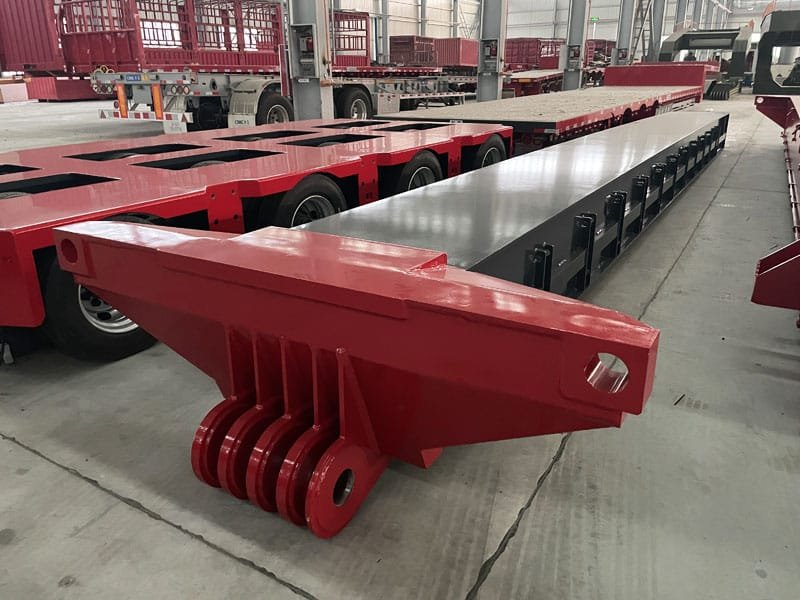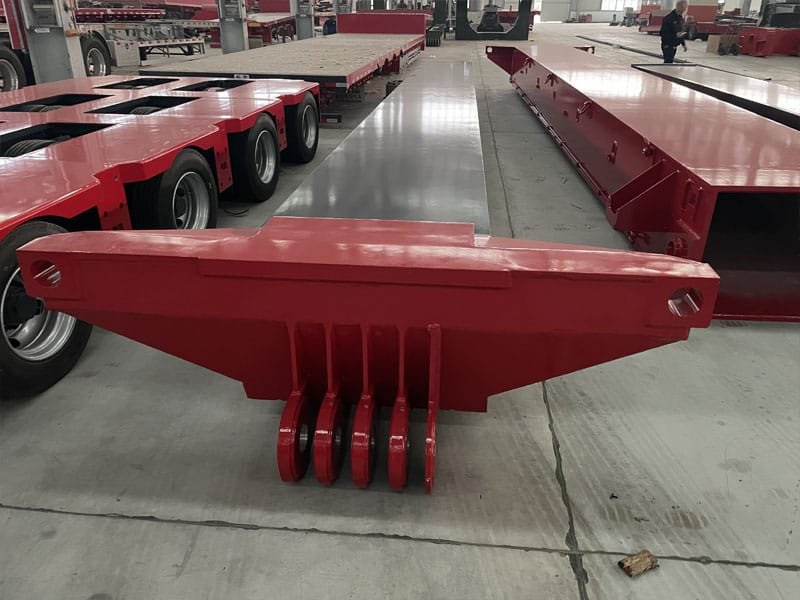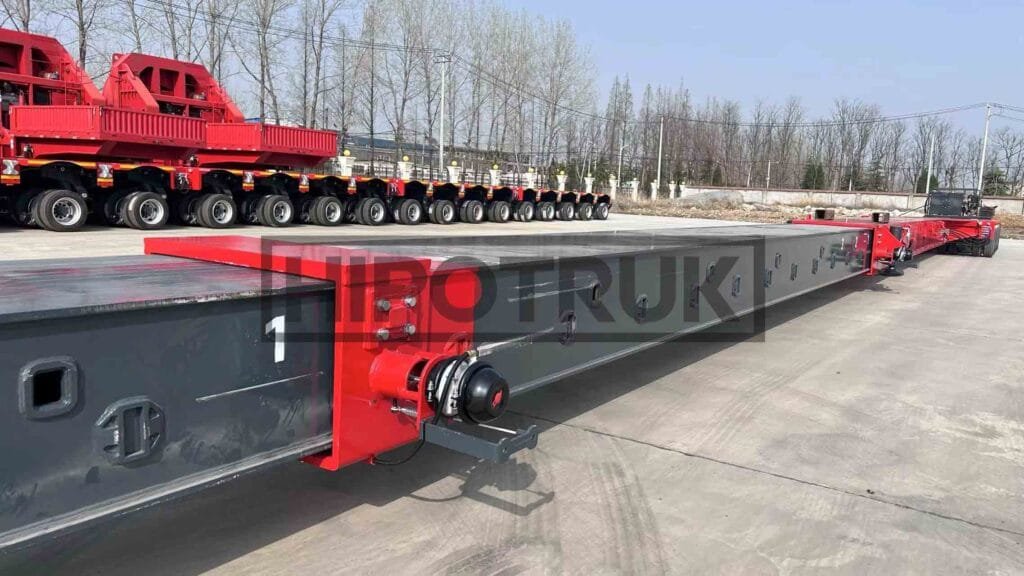Extendable spacers are essential accessories for hydraulic modular trailers, allowing trailers to handle varying cargo lengths efficiently. Selecting the right spacer involves carefully assessing load requirements, compatibility, and additional features. You can optimize your trailer’s adaptability, safety, and operational efficiency by making an informed choice.
This guide provides a detailed overview of the key factors to consider when choosing the right extendable spacer for your transport needs.
Table of Contents
ToggleWhy Extendable Spacers Are Crucial in Heavy Haulage
Extendable spacers enhance a trailer’s ability to handle oversized and long cargo by extending the loading area and adjusting axle spacing. They’re ideal for a wide range of industries, from construction and energy to specialized heavy equipment transport.



Key Benefits of Extendable Spacers
- Flexibility for Diverse Cargo: Adjust trailer length to fit different load dimensions.
- Improved Load Distribution: Balance weight evenly across axles, enhancing stability and safety.
- Cost-Effective Solution: A single extendable spacer can replace multiple specialized trailers, reducing equipment costs.
Factors to Consider When Choosing an Extendable Spacer
Choosing the right extendable spacer requires considering several critical factors that affect trailer performance, compatibility, and suitability for your operations.
1. Load Requirements
Understanding the typical and maximum load lengths you transport is essential in selecting the right extendable spacer.
- Standard Length Range: Extendable spacers generally start from 8 to 17 meters in their retracted state, extending up to 45-56 meters depending on the model. Choose a spacer with the necessary range to accommodate your longest loads.
- Compact Storage: Ensure that the spacer remains compact enough when retracted for easy storage and transport, especially if space efficiency is a priority.
2. Compatibility with Trailer System
Extendable spacers need to be compatible with your hydraulic modular trailer system for seamless integration and performance.
- Trailer Brand Compatibility: Check whether the spacer is designed for specific trailer brands, such as Goldhofer THP/SL, or if it’s compatible with multiple brands (e.g., spacers from China Hipotruk can fit various modular trailers).
- Integrated Supply Lines: Many spacers come with built-in hydraulic, brake, and electrical lines. Confirm compatibility with your trailer’s systems to ensure cohesive operation and control.



3. Load Capacity and Structural Strength
Choosing a spacer with adequate load capacity is critical to maintaining stability and safety when transporting heavy cargo.
- High-Strength Materials: Look for spacers constructed from S690 high-tensile steel or similar materials, which provide excellent durability, bending resistance, and load-bearing capacity.
- Handling the Bending Moment: Ensure the spacer is designed to withstand the bending moments required for your heaviest loads, especially for long and heavy cargo.
4. Extendability Options
Extendable spacers come in various configurations, offering different levels of length adjustment.
- Configurations: Most extendable spacers are available in 1-4 times extendable versions, providing flexibility for handling cargo of varying lengths.
- Telescopic Designs: Some models feature telescopic mechanisms for smoother extension, making it easier to adjust trailer length on-site.
- Length Adjustment Frequency: If you regularly need to adjust trailer length for different loads, choose a model that provides easy and frequent extendability.
5. Additional Features for Functionality and Ease of Use
Look for additional features that can make the spacer more functional and user-friendly, especially in demanding transport operations.
- Adjustable Hydraulic Support Legs: Some spacers offer independently adjustable hydraulic support legs, which enhance stability and allow for customization based on load requirements.
- Pneumatic Locking Pins: These pins allow for quick and secure length adjustments, saving time and improving efficiency.
- Integrated Systems: Spacers with integrated supply lines for hydraulics, brakes, and electrical systems ensure that all trailer components work together seamlessly.
6. Cost-Effectiveness and Long-Term Value
Consider the financial aspects of choosing an extendable spacer, including potential cost savings and long-term value.
- Alternative to Specialized Trailers: Extendable spacers can often replace the need for multiple specialized trailers, offering a cost-effective solution for handling diverse loads.
- Manufacturer Comparison: Compare prices and features from reputable manufacturers like Hipotruk, Supro, and China Heavy Lift to find the best balance between cost and functionality.
7. Manufacturer Support and After-Sales Service
Choosing a reliable manufacturer can make a significant difference in terms of product support and durability.
- Warranty Coverage: Ensure the manufacturer offers a warranty—some provide up to 2 years of coverage for extendable spacers, offering peace of mind.
- Customer Support: Select a supplier known for responsive customer service, including operational training, troubleshooting assistance, and replacement parts.
Steps to Choose the Right Extendable Spacer
Here’s a step-by-step approach to selecting the best extendable spacer for your transport requirements:
Step 1: Define Your Cargo Specifications
Start by identifying the typical dimensions, weight, and types of loads you transport.
- List Cargo Types: Identify the range of cargo types, such as wind turbine components, industrial machinery, or prefabricated structures, to establish your spacer needs.
- Calculate Average and Maximum Lengths: Assess the average and maximum load lengths to determine the necessary extendable range for your spacer.
Step 2: Verify Compatibility with Your Trailer System
Confirm that the spacer integrates seamlessly with your current trailer setup, including hydraulic, brake, and electrical systems.
- Check for Brand Compatibility: Verify that the spacer is compatible with your trailer brand, whether it’s Goldhofer, Nicolas, or another manufacturer.
- Confirm Integrated Systems: Ensure that the spacer’s integrated supply lines match your trailer’s setup for smooth operation.
Step 3: Evaluate Extendability and Load Capacity
Consider how frequently you need to adjust the trailer length and ensure the spacer can handle the load weight.
- Choose Extendable Configurations: If your transport needs vary frequently, a spacer with multiple extension stages (1-4 times extendable) can provide flexibility.
- Assess Load Capacity: Verify that the spacer’s load capacity aligns with your heaviest loads and offers adequate bending resistance for stable transport.
Step 4: Consider Additional Functional Features
Explore additional features that can enhance ease of use and improve functionality.
- Adjustable Legs and Locking Pins: For greater convenience, look for spacers with hydraulic support legs and pneumatic locking pins for easy adjustments.
- Optional Precambering: If you often transport high-center-of-gravity loads, precambering can improve load support and stability.
Step 5: Consult with the Manufacturer
Engage with reputable manufacturers to discuss your specific requirements and customization options.
- Request Detailed Specifications: Obtain technical specifications and customization options to ensure the spacer fits your exact needs.
- Discuss Warranty and Support: Confirm warranty terms and after-sales support to secure a long-term investment.
Summary: Choosing the Right Extendable Spacer for Your Transport Needs
Choosing the ideal extendable spacer is crucial for maximizing your hydraulic modular trailer’s safety, efficiency, and flexibility. By considering load requirements, compatibility, material quality, and additional features, you can make an informed choice that enhances your trailer’s performance.

Key Takeaways
- Assess Load Lengths and Capacity: Choose a spacer with the right extendable range and load-bearing capacity to accommodate your transport needs.
- Confirm Compatibility: Ensure the spacer integrates seamlessly with your trailer system, including hydraulic, brake, and electrical lines.
- Prioritize Functional Features: Quick locking pins, hydraulic support legs, and precambering can enhance functionality and stability.
- Select a Reliable Manufacturer: Choose a reputable manufacturer with strong customer support and warranty coverage for long-term value.
By selecting the right extendable spacer, you can make your hydraulic modular trailer more versatile and adaptable, ensuring safe, efficient, and cost-effective transport for various cargo types.